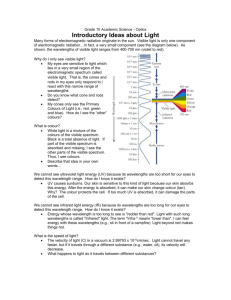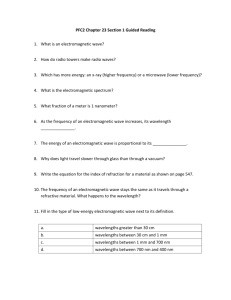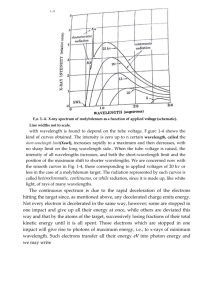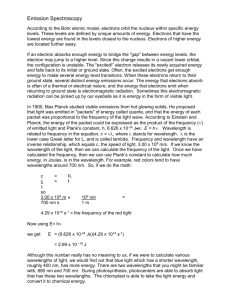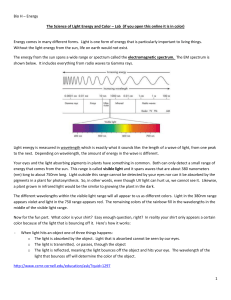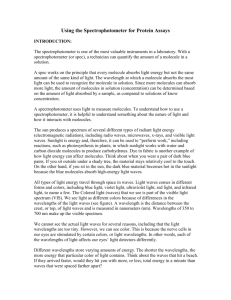Reflection - SD54 Special Olympics
advertisement
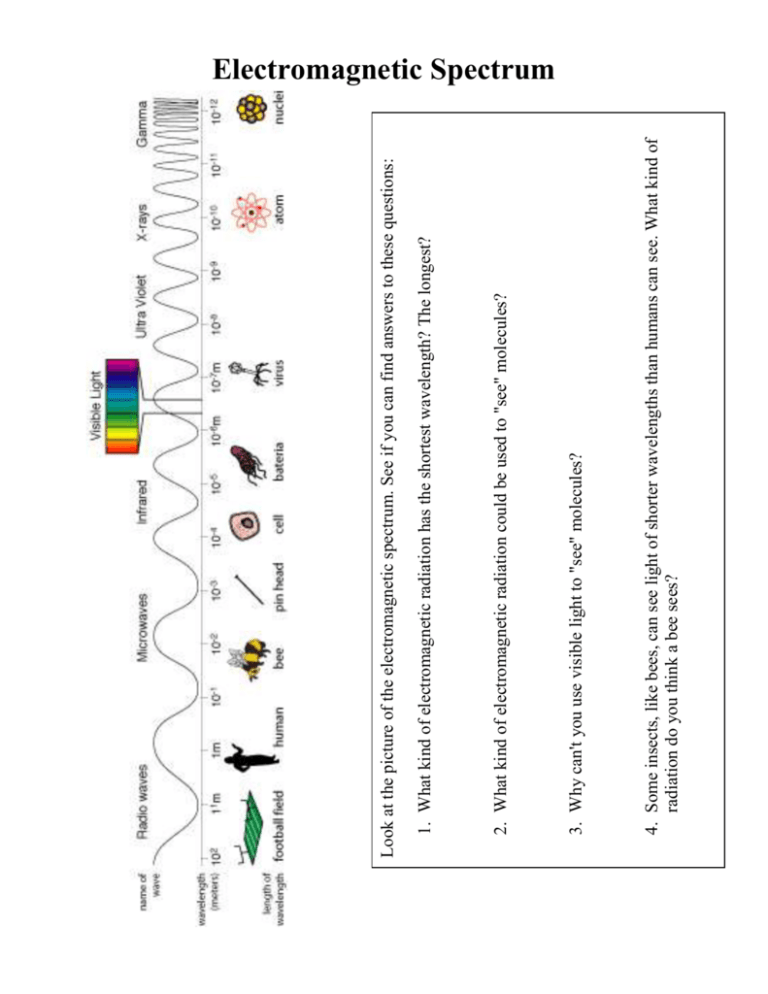
4. Some insects, like bees, can see light of shorter wavelengths than humans can see. What kind of radiation do you think a bee sees? 3. Why can't you use visible light to "see" molecules? 2. What kind of electromagnetic radiation could be used to "see" molecules? 1. What kind of electromagnetic radiation has the shortest wavelength? The longest? Look at the picture of the electromagnetic spectrum. See if you can find answers to these questions: Electromagnetic Spectrum Electromagnetic Waves Light waves across the electromagnetic spectrum behave in similar ways. When a light wave encounters an object, they are either transmitted, reflected, absorbed, refracted, polarized, diffracted, or scattered depending on the composition of the object and the wavelength of the light. Specialized instruments onboard NASA spacecraft and airplanes collect data on how electromagnetic waves behave when they interact with matter. These data can reveal the physical and chemical composition of matter. Reflection Reflection is when incident light (incoming light) hits an object and bounces off. Very smooth surfaces such as mirrors reflect almost all incident light. The color of an object is actually the wavelengths of the light reflected while all other wavelengths are absorbed. Color, in this case, refers to the different wavelengths of light in the visible light spectrum perceived by our eyes. The physical and chemical composition of matter determines which wavelength (or color) is reflected. This reflective behavior of light is used by lasers onboard NASA's Lunar Reconnaissance Orbiter to map the surface of the Moon. The instrument measures the time it takes a laser pulse to hit the surface and return. The longer the response time, the farther away the surface and lower the elevation. A shorter response time means the surface is closer or higher in elevation. In this image of the Moon's southern hemisphere, low elevations are shown as purple and blue, and high elevations are shown in red and brown. Absorption Absorption occurs when photons from incident light hit atoms and molecules and cause them to vibrate. The more an object's molecules move and vibrate, the hotter it becomes. This heat is then emitted from the object as thermal energy. Some objects, such as darker colored objects, absorb more incident light energy than others. For example, black pavement absorbs most visible and UV energy and reflects very little, while a light-colored concrete sidewalk reflects more energy than it absorbs. Thus, the black pavement is hotter than the sidewalk on a hot summer day. Photons bounce around during this absorption process and lose bits of energy to numerous molecules along the way. This thermal energy then radiates in the form of longer wavelength infrared energy. Thermal radiation from the energy-absorbing asphalt and roofs in a city can raise its surface temperature by as much as 10° Celsius. The Landsat 7 satellite image below shows the city of Atlanta as an island of heat compared to the surrounding area. Sometimes this warming of air above cities can influence weather, which is called the "urban heat island" effect. Diffraction Diffraction is the bending and spreading of waves around an obstacle. It is most pronounced when a light wave strikes an object with a size comparable to its own wavelength. An instrument called a spectrometer uses diffraction to separate light into a range of wavelengths— a spectrum. In the case of visible light, the separation of wavelengths through diffraction results in a rainbow. A spectrometer uses diffraction (and the subsequent interference) of light from slits or gratings to separate wavelengths. Faint peaks of energy at specific wavelengths can then be detected and recorded. A graph of these data is called a spectral signature. Patterns in a spectral signature help scientists identify the physical condition and composition of stellar and interstellar matter. The graph to the left from the SPIRE infrared spectrometer onboard the ESA (European Space Agency) Herschel space telescope reveals strong emission lines from carbon monoxide (CO), atomic carbon, and ionized nitrogen in Galaxy M82. Scatter Scattering occurs when light bounces off an object in a variety of directions. The amount of scattering that takes place depends on the wavelength of the light and the size and structure of the object. The sky appears blue because of this scattering behavior. Light at shorter wavelengths— blue and violet—is scattered by nitrogen and oxygen as it passes through the atmosphere. Longer wavelengths of light—red and yellow—transmit through the atmosphere. This scattering of light at shorter wavelengths illuminates the skies with light from the blue and violet end of the visible spectrum. Even though violet is scattered more than blue, the sky looks blue to us because our eyes are more sensitive to blue light. Aerosols in the atmosphere can also scatter light. NASA's Cloud-Aerosol Lidar and Infrared Pathfinder Satellite Observation (CALIPSO) satellite can observe the scattering of laser pulses to "see" the distributions of aerosols from sources such as dust storms and forest fires. The image below shows a volcanic ash cloud drifting over Europe from an eruption of Iceland's Eyjafjallajökull Volcano in 2010. Refraction Refraction is when light waves change direction as they pass from one medium to another. Light travels slower in air than in a vacuum, and even slower in water. As light travels into a different medium, the change in speed bends the light. Different wavelengths of light are slowed at different rates, which causes them to bend at different angles. For example, when the full spectrum of visible light travels through the glass of a prism, the wavelengths are separated into the colors of the rainbow. Electromagnetic Waves
